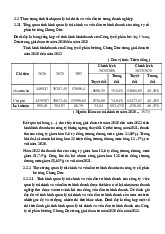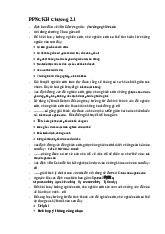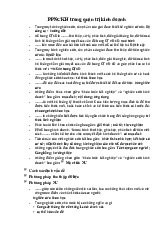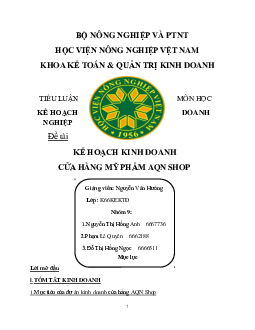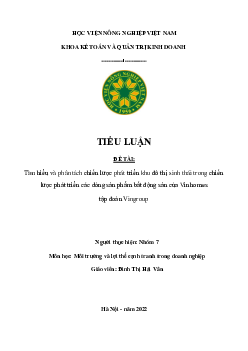






















Preview text:
VIETNAM NATIONAL UNIVERSITY OF AGRICULTURE
FACULTY OF ACCOUTING AND BUSINESS MANAGEMENT
INTERNSHIP REPORT
Group of Student: 1.
Pham Thi Hien – 642290 – K64QTKDT 2.
Nguyen The Long – 645125 – K64QTKDT 3.
Vu Thu Ha – 641599 – K64QTKDT
Lecture: Ph.D Tran Minh Hue
HA NOI, 2021
VIETNAM NATIONAL UNIVERSITY OF AGRICULTURE
FACULTY OF ACCOUTING AND BUSINESS MANAGEMENT
INTERNSHIP REPORT
Group of Student: 1.
Pham Thi Hien – 642290 – K64QTKDT 2.
Nguyen The Long – 645125 – K64QTKDT 3.
Vu Thu Ha – 641599 – K64QTKDT
Lecture: Ph.D Tran Minh Hue
HA NOI, 2021 ACKNOWLEDGEMENT
Dear Teachers, this is the first internship, so it means a lot to us, 3rd
year students who are still sitting in the university lecture hall. Because in
addition to cultivating specialized knowledge and skills, internships at
enterprises and preparing necessary skills to complete the graduation thesis
are also very important. It is an opportunity for us to have access to the real
working environment at companies and businesses, and to apply the theory
taught in school to real work. Especially thanks to that, we have gained the
experience and skills as the basis for the final thesis internship.
After 5 weeks of internship, receiving guidance and help from teachers
and the company, our group of students including Pham Thi Hien, Nguyen
The Long, Vu Thu Ha came from K64 Advanced Agribusiness Administration
(K64QTKDT) successfully completed the first practical training session at
GPV Vietnam CO., LTD with the topic of general understanding of the
Company's business operations. During the internship period, we had many
opportunities and conditions to learn, research and collect comprehensively
information from the history of formation and development, organizational
structure, business fields. to the market, processes, production activities and
business results of the company. Thereby helping us to better understand the
company in all aspects and complete the Internship Report on the company.
We sincerely thank Instructor Ph.D Tran Minh Hue, Lecturer in
Accounting and Business Administration Faculty, Vietnam National Academy
of Agriculture, Mr. Vu Tien Thinh and the Board of Directors of GPV
VIETNAM CO., LTD. The staff in the company enthusiastically guided and
helped us during the internship period and wrote the report.
Due to many limitations in knowledge as well as practice time, the
report cannot avoid errors, our team would like to receive comments and
guidance from teachers to report the internship program 1 of our group is more complete. We sincerely thank you! ii
TABLE OF CONTENTS
CHAPTER 1. INTRODUCTION..............................................................................1 1.
Introduction ...................................................................................................1 1.1.
The rationale of the internship report .......................................................1 1.2.
Report objectives .........................................................................................2
1.2.1. General objective .........................................................................................2
1.2.2. Specific objective .........................................................................................2 1.3.
Scope of report ............................................................................................2
1.3.1. Scope of space ............................................................................................2 1.4.
Report methodology ....................................................................................3
1.4.1. Data collection ..............................................................................................3
1.4.2. Statistical method ........................................................................................3
1.4.3. Analytical method ........................................................................................3
1.4.4. Synthesis .......................................................................................................3
CHAPTER 2: FINDING ............................................................................................4 2.
Finding ...........................................................................................................4 2.1.
Introduction of a company..........................................................................4 2.2.
Operating characteristics and consumption market ..............................5 2.3.
Resources and Facilities ............................................................................5
2.3.1. Organization stucture ..................................................................................5
2.3.2. The main product.........................................................................................7
2.3.3. Equipment .....................................................................................................9 2.4.
Business results of the company in 3 years ........................................ 10 2.5.
Performance Analysis .............................................................................. 13
CHAPTER 3: CONCLUSIONS AND RECOMMENDATIONS........................ 15 3.
Conclusions and Recommendations ..................................................... 15 3.1.
Conclusions ............................................................................................... 15 3.2.
Recommendations .................................................................................... 15
LIST OF TABLES
Table 2.1: Income Statement from 2019-2021 (Unit: VND). . .10 iv
CHAPTER 1. INTRODUCTION 1. Introduction 1.1.
The rationale of the internship report
To complete practical course 1st
Help students with practical approach and apply the knowledge they
have learned in practical production and business at production facilities.
Because the student who does an internship receives credit from the
university, graded credit determined by the technical writing faculty, there
needs to be documentation in addition to the site supervisor's evaluation as a
basis for that graded credit. Submitting an internship report not only provides
the faculty with a document which qualifies the student for graded credit, it
also provides the faculty with in-depth information about the profession they
are responsible for preparing students to participate in. Furthermore, and of
considerable importance, the internship report increases the student's
responsibility by requiring the student intern to gather information and plan
the report throughout the work experience. The student then has an
opportunity to demonstrate maturity as a technical writer by presenting,
analyzing, and evaluating his or her own work on the job.
Responding the demand of faculty accounting and business
management also our requirement.
The concept of business analysis
In the most general sense is the process of studying all phenomena and
things directly and indirectly related to human production and business
activities. The analysis process is carried out from the step of actual
investigation to abstract thinking from observing reality, collecting data
information, processing and analyzing data information, finding the cause to
the decision. set out operational orientations and solutions to implement those orientations.
The main content of business analysis is the business results indicators
such as sales revenue, production value, cost, profit,etc. When analyzing, it is
necessary to clearly understand the boundary between quantitative criteria and
quality indicators, absolute, relative, average,etc.
Deeply research the factors affecting the performance of business results on those targets.
1.2. Report objectives
1.2.1. General objective
Clarify the current status of business activities in the company. Observe
the operation, thereby proposing some solutions related to business performance.
1.2.2. Specific objective
Firstly, contribute to systematizing the theoretical and practical basis of
business activities and resreach the history of GPV VIET NAM TECHNOLOGY COMPANY LIMTED.
Secondly, understand the organization, human resource, understand the
process of producing product, and their products and analyze financial status in 3 years ago.
Finally, Proposing some solutions to improve the efficiency of the
company's business operations. 1.3.
Scope of report
1.3.1. Scope of space
Research at GPV VIET NAM TECHNOLOGY COMPANY LIMTED.
Address: Vat Cach Village, Dong Cuong Commune, Yen Lac District,
Vinh Phuc Province, Vietnam.
1.3.2. Scope of time
From 22/11/2021 to 26/12/2021: go to practice GPV VIET NAM
TECHNOLOGY COMPANY LIMTED and get information
From 27/12/2021 to 03/02/2022: Write the report 2
1.4. Report methodology
1.4.1. Data collection
Data collection is the process of gathering and measuring information
on targeted variables in an established system, which then enables one to
answer relevant questions and evaluate outcomes.
Secondary data: From available materials of GPV VIET NAM TECHNOLOGY COMPANY LIMTED.
Primary data: Using observe to survey.
1.4.2. Statistical method
Based on the report which GPV VIET NAM TECHNOLOGY
COMPANY LIMTED give for us: Asset, liability, machines, material,etc.
Statistical methods are mathematical formulas, models, and techniques
that are used in statistical analysis of raw research data. The application of
statistical methods extracts information from research data and provides
different ways to assess the robustness of research outputs.
1.4.3. Analytical method
An analytical technique (analytical method) is a procedure or a method for
the analysis of some problem, status or a fact. Analytical techniques are usually
time-limited and task-limited. They are used once to solve a specific issue.
Using the financial statement to analyze based on the outside factors
and inside factors; using excels software to compute; using diagram, table,etc. 1.4.4. Synthesis
Research synthesis is the overarching term we use to describe
approaches to combining, aggregating, integrating, and synthesizing primary
research findings. Each synthesis methodology draws on different types of
findings depending on the purpose and product of the chosen synthesis
Synthesis the data in financial statement, in the table. For example:
table show the number of employees and equipment of GPV VIET NAM TECHNOLOGY COMPANY LIMTED.
CHAPTER 2: FINDING 2. Finding 2.1.
Introduction of a company General Information
Name: GPV VIET NAM TECHNOLOGY COMPANY LIMTED.
Address: Vat Cach Village, Dong Cuong Commune, Yen Lac District, Vinh Phuc Province, Vietnam Director is Mr. Vu Tien Thinh
GPV VN CO.,LTD operates mainly in the field of food processing
History and Development: Company was founded in September 29, 2019.
GPV Vietnam Technology Co., Ltd, formerly known as VEGAN
PARADISE COMPANY LIMITED (VEGETARIAN PARADISE COMPANY
LIMITED) was established in 2012, co-founded by Mr. Tuong Ngoc Tan and Mr.
Vu Tien Thinh, with address at Address: No. 16, lane 18, Ta Thanh Oai, Ta Thanh
Oai Commune, Thanh Tri District, Hanoi City. The main business of the company
is the production and supply of ready-to-eat foods.
In 2019, realizing the increasing market demand, the company
expanded its operations and established GPV Vietnam Technology Co., Ltd.
under the management and administration of Mr. Vu Tien Thinh. The
company operates in the field of food processing and technology transfer for
pastry processing. The company was initially headquartered in Vinh Phuc
with a total area of 2000m2 (of which 600m2 was used as a factory).
In 2020, the Company expanded its factory area to 8000m2, launched the
high-class pastry brand Cindy, and opened a representative office in Hanoi.
Currently, the Company is investing in opening a high-class bakery factory
in Phu Tho with a total area of up to 5000m2, increasing the capacity to 5 tons of
flour per day. New investment in carton and plastic tray production lines, in order
to proactively provide a part of packaging for products. 4 2.2.
Operating characteristics and consumption market
Currently, the company is manufacturing and supplying cakes and instant
cakes every day. In addition, the company also transfers production technology to
facilities and factories in the fields of pastry processing technology and imports
equipment, technology and raw materials for food production.
The company's products are a favorite and always selling well at
convenience stores in the Northside of Vietnam, most in Hanoi, Vinh Phuc
and Phu Tho. In which, Hanoi is the highest consumption area, accounting for
60% of the company's total product output. The convenience stores that the
company chooses to cooperate with are small and medium-sized, with evenly
distributed items, so consumers can easily access the products. The company
is gradually moving towards distributing products in large chain of
convenience stores such as Vinmart, Tomita, Dalatfarm to reach out to more
demanding customers in the big urban area.
2.3. Resources and Facilities
2.3.1. Organization stucture
Currently, GPV Vietnam Technology Co., Ltd has about 30 employees
including workers and board of directors. All workers, when recruited into the
factory, are thoroughly trained in food hygiene and safety and all of the
employee working in the department must meet the company's recruitment
requirements in terms of qualifications and experience. CHIEF EXECUTIVE DIRECTOR (CEO) DEPUTY DEPUTY BUSINESS TECHNICAL DIRECTOR DIRECTOR BUSINESS ADMINITRATION ACCOUNTING TECHNICAL DEPARTMENT DEPARTMENT DEPARTMENT DEPARTMENT
Chief Executive Direct (CEO) of the company is Mr. Vu Tien Thinh.
He is also the founder of GPV. His responsibilities are manages and directs
the company toward its primary goals and objectives. Oversees employment
decisions at the executive level of the company. Leads a team of executives to
consider major decisions including acquisitions, mergers, joint ventures, or large-scale expansion.
Deputy Business Director is Mr. Vu Tien Thinh has responsible for
overseeing the development of an organization's business goals and
objectives. They typically work to increase business revenue, identify and
develop business opportunities, and expand the company's presence and its brands.
Deputy Technical Director is Mr. Vu The Vuong has responsible for
recording the technical specifications of the products they use to maintain
consistency throughout the production process. He also makes purchases of
tech systems, oversee their installation and train their staff to use the new technology during production. 6 Business Department include marketing, finance, operations
management, human resource, and IT. These five divisions represent the
major departments within a publicly traded company, though there are often
smaller departments within autonomous firms.
Adminitration Departmant is important to any company because it
works across all departments and with all kinds of work. The functions of the
Admin Department include General Office Management; Asset Management;
Transport Management and Security and Safety Management.
Accounting Department records accounts payable and receivable,
inventory, payroll, fixed assets and all other financial elements. The
department's accountants review the records of each department to determine
the company's financial position and any changes required to run the company cost-effectively.
Technical Department has fuctions that manage, implement and inspect
technical work, ensure work progress, saftey, quality and economic efficiency
in company; management of using, reparing, purchasing equipments,
machines for business operations in company.
2.3.2. The main product
Salted shredded meat hamburger
(Net weight: 55g, Price 8,000-10,000/piece)
This is the company's first salty cake product. It is a best-selling
product, loved and trusted by consumers. Buttermilk hamburger
(Net weight: 55g, Price: 6,000-8,000/piece).Buttermilk hamburger
providesdelicious, convenient and nutrition.
Grape coconut milk bread (Net weight: 250g, Price 25,000- 30,000/piece).
This is a sold-out product as soon as it hits the shelves of GPV's high- end cake line. 8
Chrysanthemum bread (Net weight: 250g, Price 25,000-30,000/piece).
GPV's chrysanthemum bread product lines also possess extremely rich
nutritional content, suitable to be used by all ages. 2.3.3. Equipment
Although GPV is a young company, they invests in very modern
equipment and machinery to create high quality bakery products with
beautiful shapes, saving time and expenses for customers, workers and most
importantly, ensure food safety for products. A full set of cake production
lines with full equipment, high productivity, cost-effective support for bread-
making technology transfer include: Machine 1: Dough Mixer Machine 2: Cake Depositor Machine 3: Rotary Oven
Machine 4: Cake Filling Machine Machine 5: Cooling Conveyor Machine 6: Sterilization
Machine 7: Nitrogen Generator Set
Machine 8: Cake Packing Machine Machine 9: Date Printer 2.4.
Business results of the company in 3 years
Table 2.1: Income Statement from 2019-2021 (Unit: VND) Source: Business department Revenue
In 2019, the company's revenue reached more than 25 billion VND, by
2020 it will reach more than 30 billion VND, an increase of about 5 billion
VND. In 2021, the revenue suddenly increased by nearly one and a half times
higher, about 46 billion VND, an increase of nearly 15 billion VND compared
to 2020. It can be said that the company's revenue has a relatively fast growth.
It proves that the company has constantly made efforts to negotiate, seek to
expand economic relationships in order to increase revenue, and also show
that the quality of products of the enterprise is increasingly improved, created
reputable in the market. In 2019, the company's revenue was 25,623,489,000
VND. This is the year that GPV Technology Co., Ltd. has brought high-class
bakery products to the market. Thanks to this step forward, GPV's revenue in
2020 has increased by nearly 1.2 times. Another reason why revenue is
constantly growing is that the company is very diligent in researching and
understanding customers' tastes to launch new products on special holidays.
Not only that, GPV's products are also constantly innovating in terms of
design to meet the maximum needs of customers. The period 2020-2021 is a
difficult period because the COVID-19 epidemic creates many challenges for
most industries and business fields, but for food industry enterprises, 10
especially leading ones then there are many opportunities. Even, many food
businesses have outstanding business results thanks to flexibility and taking
advantage of available advantages. Adapting to the epidemic, in the context of
a complicated pandemic, many provinces and cities implement the distance,
businesses face difficulties, but there are still food businesses that rise to
dominate market share, large revenue growth and profit. This business has a
great advantage thanks to a closed ecosystem from production to distribution.
Thanks to that, even during the epidemic, the company was still flexibly
adapting, seizing opportunities to gain market share, and achieved impressive
business results. In 2021, the company's revenue is 45,965,621,000 VND, an
increase of more than 15 billion VND. Explaining this, besides the reasons
mentioned above, it must be mentioned that GPV officially started
construction of the factory in Phu Tho. Factory project in Phu Tho on an area
of 5,000m2, including building a factory and investing in a coconut grape cake
production line. The investment in phase 1 of a factory in Phu Tho is expected
to increase Bibica's average annual revenue by more than 40 billion
VND/year and the fact that revenue in 2021 has increased by more than 30
billion VND compared to the previous year 2020. Expense
Through the above analysis, we can see that the company's total
business expenses increased relatively quickly, in 2019 it was nearly 6 billion
VND, but in 2020 it is more than 7 billion VND. In 2021, the company's total
business expenses are nearly 11 billion VND. The fluctuation in selling
expenses from 2019 to 2020 is VND 1,165,683,000. The fluctuation of selling
expenses in 2020 - 2021 is VND 3,711,342,500. Specifically, fluctuations in
selling and administrative expenses are as follows. Selling expenses in the
period of 2019 - 2021, the proportion of selling expenses in total revenue
increased continuously. In 2019, selling expenses were nearly 4 billion VND,
in 2020 it was 4.8 billion VND. In 2021, selling expenses are more than 7
billion VND. The fluctuation in selling expenses for 2019–2020 is VND
777,122,000. The fluctuation of selling expenses in 2020-2021 is VND
2,474,228,333. Although selling expenses increased, the expense ratio
decreased. Administration expenses in 2019 reached nearly 2 billion VND.
The volatility of 2019 - 2020 is 388,561,000 VND. The 2020-2021 volatility
is 1,237,114,167 VND. Similar to selling expenses, although administrative
expenses have increased over the years. However, although selling expenses,
general and administrative expenses, and total operating expenses increased,
the expense ratio still decreased. That's because the company has applied the
advancement of science and technology, using software to help plan
enterprise resources. The company has fully applied the features of the
software suite, including: Accounting and Finance Management, Sales
Management, Purchasing Management, Warehouse Management, Production
Management. This helps GPV manage business activities more scientifically.
Therefore, although selling and administrative expenses still increased, but
the company managed well, so the expense ratio over the years still decreased. Profit
In 2019, GPV's total pre-tax profit reached nearly VND 18 billion. In
2020, this number has reached over 21 billion VND and increased by more
than 3 billion VND compared to 2019. From 2020 to 2021, the total profit
before tax of enterprises has increased faster than the period of 2019-2020,
reaching a high level. nearly 33 billion VND. In general, the profit structure
of the enterprise does not have many significant changes. In the period of
2019 - 2020, profit from production and business activities increased by more
than 3 billion VND. Besides, other profit increased by more than 300 million
dong. However, because it accounts for a small proportion of the total profit,
this figure, although large, does not affect the growth of the total profit. From
2020 to 2021, the profit from production and business activities increased 12
sharply, more than 10 billion VND. At the same time, other profits increased
by more than 1 billion dong. High-class cakes or steamed cakes are consumed
strongly in the midst of the pandemic. With high profit margins, modern sales
channels will create new growth drivers. The COVID-19 pandemic has
changed consumption trends, creating opportunities for modern distribution
channels to develop rapidly as people choose to shop online at home and
supermarkets with quality products. and origin. 2.5.
Performance Analysis Strength
In general, the company's revenue increased rapidly from VND 25.6
billion to nearly VND 46 billion mainly because the company expanded the
market and improved product quality.
GPV is a brand on the rise in the Vietnamese confectionery market
today. The company focuses on improving product quality and building a
brand name in the market. Part of that is because the company has constantly
researched and understood the tastes of customers to launch new products on
special holidays and care about the needs of all customers of all ages.
GPV is a company with quite good asset utilization efficiency,
especially current asset utilization efficiency. The number of days of a
working capital turnover is relatively fast compared to other companies in the
same industry, Bibica's solvency is relatively good, it can avoid the pressure
of debt repayment as well as the ability to raise capital easily. The company
currently has 35 distributors, of which 12 distributors of the Company's
products have been consumed in Hanoi city, 9 distributors in Vinh Phuc
province factory, 8 distributors in Phu Tho province and the remaining 6
distributors in other provinces. Weakness
The increase in the cost of input materials of the product due to the
Covid epidemic affects the company's revenue and is also a difficult problem
for the company to increase or keep the product price unchanged.
Currently, students and workers are mainly working remotely due to the
Covid epidemic, so the purchasing power of the company's products is less than
before. Over the past three years, the company's total expenses increased quite
rapidly in 2019 from nearly 6 billion VND to 11 billion VND in 2021. Because
the company spent too much on selling expenses. Although revenue increased, the
company's profit did not increase as expected, which is reflected in the company's
low profit-to-revenue ratio. Therefore, to meet the needs of development, the
company needs to take measures to improve profits in the future. Opportunities
Bread and instant products are essential necessities, so the demand for the
company's products is increasing, especially during the Covid-19 pandemic. The
company is currently expanding its production plant in Vinh Phuc and opening a
new factory in Phu Tho will increase the company's production capacity, fully
meeting the needs of the market in Hanoi and the northern provinces. At the
same time, this is also a good opportunity to expand the market of the product to
the central provinces and especially the southern market. The Covid-19 epidemic
also created opportunities for the Company to promote its brand and increase
revenue from isolation areas and hospitals. Thearts
Currently, many companies and units are also entering the market of
instant cake production, so there will be many competitors, requiring the
company to improve and diversify products and innovate to meet the needs of
customers. increasing consumer demand. Imported bakery products are also
increasing due to Vietnam's accession to AFTA, the import tax rate of
confectionery products will be reduced, so the selling price of these products
can be more competitive, which consumers Vietnam is also very fond of
imported goods, which will be a challenge for the company's products. 14
PTER 3: CONCLUSIONS AND RECOMMENDATIONS 3.
Conclusions and Recommendations 3.1. Conclusions
Despite facing pressure from partners and difficulties of the economy,
GPV has continuously expanded its investment for 3 years now. From the
construction of a steam cake production line at the factory in Vinh Phuc to the
construction of a new factory in Phu Tho. All In 2021, GPV invests in 2 new
production lines. It is expected that in 2022, these two lines will bring the
Company an additional VND 40 billion and the Company's market share will
increase to 5%. If 100% capacity is fully exploited, GPV's market share will
increase to 10% market share. The Company's vision to 2025 will be to
become a leader in the confectionery industry in Vietnam are aimed at making
GPV the leading confectionery brand in the market. To get there, we had to
scale up, increase our selling point, and increase our reach. And before that,
new factories were invested and built. When the factory in Phu Tho comes
into operation, GPV's output can double provide quality products at
reasonable prices. Upgrading the value chain through collaborative
participation, responsibility of the owner and proper training Develop an
effective distribution network Expand the activities of affiliated units through partners above Global. 3.2. Recommendations Increase revenue.
Abou the product quality, enhance the role of the quality system
management function and inspect and monitor the processes at the company's
quality management department to ensure the quality of the product. Establish
a self-inspection, supervision mechanism in all departments, to ensure that
each department and workshop must have sufficient data and records to be
statistically analyzed for operational management and improvement.
continuous progress. Make the most of the available resources into the main
activities of the company, avoiding waste or improper use. Promote marketing
and sales, the company should have a strategy to develop a suitable sales
system. In the immediate future, it is necessary to focus on expanding the
market share of old customers through measures to stabilize prices, diversify
products in the market and strengthen customer care. Gradually develop and
expand market share for potential and new customers. Establishing a team
specializing in competitor research to advise the leadership, the business
department to change - improve management - technology in a timely manner
to maintain competitive advantage. Enterprises should have a reasonable view
and assessment of the risk of debt collection occurring to reduce receivables.
Striving to complete the facilities, sell good quality products to increase
prestige and enhance competitiveness. Reduce the cost
It is necessary to diversify suppliers to have competition in price and
quality of input materials. Continue to review and improve the cost control
system in each department and workshop with the goal of maximizing
existing resources and minimizing costs. Having a policy to manage and
control expenses that are reasonable with the revenue and profit derived from
that increase in costs. Like expenses, typically marketing costs and sales
department salaries increase too quickly, this can increase revenue but also
reduce profits. Therefore, the company needs to make the most of the
resources to avoid the case where the costs are too much compared to the
profits achieved. The company needs to control the growth of financial costs,
by reducing inventory and investments to reduce bank loans, reduce interest
expenses, calculate capital needs each period to have plan to use loan capital
effectively in the period of high inflation economy. Control and use the
unused portion of fixed assets to save maximum costs. Manage inventory
rationally and effectively, minimizing storage costs. There is a department 16
that regularly reviews and strictly manages the transportation process as well
as the preservation of goods to minimize possible damage and loss. There is a
reasonable mechanism of punishment as well as reward to encourage
individuals and departments to well implement the cost control plan at their
units. The company should have a policy to urge as well as quickly complete
the factory project in Phu Tho and put it into stable operation in order to
minimize fixed costs (such as land rent). Manage Accounts Receivable
The company should limit the amount of outstanding capital in
payment. To do that, the company must implement a number of solutions as
follows: Apply policies to encourage customers to pay quickly: payment
discount. It is necessary to evaluate and classify customers based on the
history of trading relationships between the company and customers, or
evaluate the business and financial activities of the customer. If good
customers sell in large volume, average customers sell in limited volume,
weak customers should not sell on credit. Strictly control debt monitoring and
debt collection. Evaluate and make reasonable provision for receivables for
bad debts. Legally handle the case of overdue debt intentionally entangled,
appropriating capital of the company. Manage Accounts Payable
The company should adjust short-term assets reasonably so that it can both
ensure the payment of debts and use capital more efficiently, and at the same
time, avoid long-standing inventory stagnation to reduce quality and
reputation. with customers while at the same time ensuring solvency in the
short term. If the economy is stable, the company should consider taking
advantage of financial leverage by increasing the debt ratio to a safe level of
debt in order to make the most of debt instead of self-financing. equity and
tax savings from the use of debt, increasing net income. In the context of the
current high inflation economy, the company should consider reducing the
debt ratio below the debt safety level. Defining the functions and duties of
specific departments. Create conditions for management staff to learn and
improve their professional qualifications. In order to promote the ability and
complete the assigned tasks effectively, the company needs to encourage and
timely reward individuals and groups with outstanding achievements in
management as well as in production. 18

